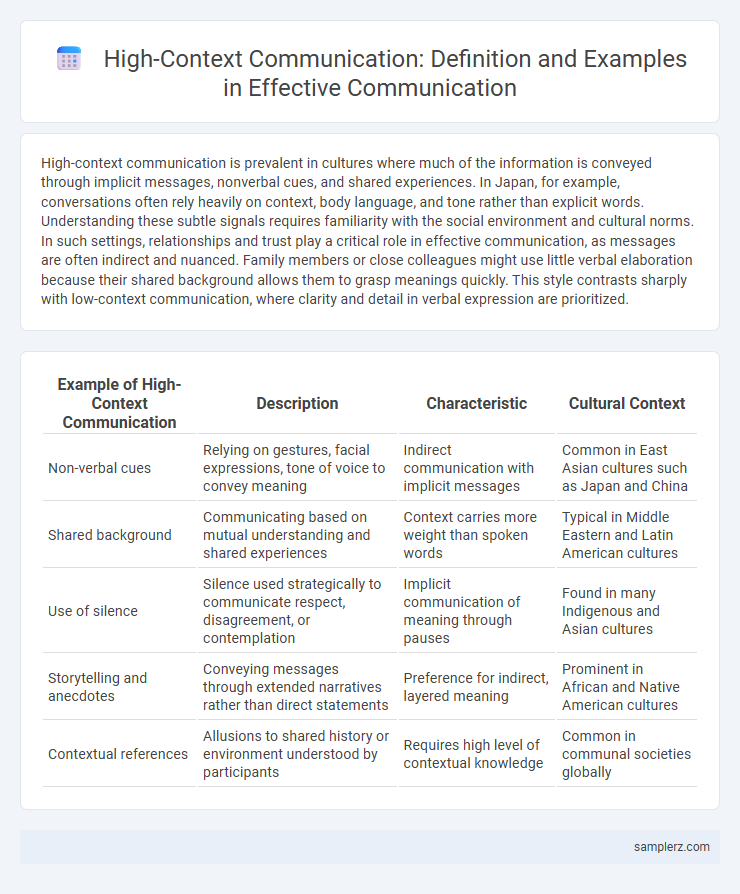High-context communication is prevalent in cultures where much of the information is conveyed through implicit messages, nonverbal cues, and shared experiences. In Japan, for example, conversations often rely heavily on context, body language, and tone rather than explicit words. Understanding these subtle signals requires familiarity with the social environment and cultural norms. In such settings, relationships and trust play a critical role in effective communication, as messages are often indirect and nuanced. Family members or close colleagues might use little verbal elaboration because their shared background allows them to grasp meanings quickly. This style contrasts sharply with low-context communication, where clarity and detail in verbal expression are prioritized.
Table of Comparison
| Example of High-Context Communication | Description | Characteristic | Cultural Context |
|---|---|---|---|
| Non-verbal cues | Relying on gestures, facial expressions, tone of voice to convey meaning | Indirect communication with implicit messages | Common in East Asian cultures such as Japan and China |
| Shared background | Communicating based on mutual understanding and shared experiences | Context carries more weight than spoken words | Typical in Middle Eastern and Latin American cultures |
| Use of silence | Silence used strategically to communicate respect, disagreement, or contemplation | Implicit communication of meaning through pauses | Found in many Indigenous and Asian cultures |
| Storytelling and anecdotes | Conveying messages through extended narratives rather than direct statements | Preference for indirect, layered meaning | Prominent in African and Native American cultures |
| Contextual references | Allusions to shared history or environment understood by participants | Requires high level of contextual knowledge | Common in communal societies globally |
Understanding High-Context Communication: A Brief Overview
High-context communication relies heavily on implicit messages, shared experiences, and non-verbal cues, common in cultures like Japan and Arab countries. Understanding this style requires attentiveness to tone, body language, and the environment rather than explicit words. Effective interaction in high-context settings enhances relationship-building and reduces misunderstandings by leveraging underlying social knowledge.
Cultural Roots of High-Context Communication
High-context communication is deeply rooted in cultures such as Japan, China, and Arab countries, where shared history, traditions, and social norms play a critical role in conveying meaning. In these cultures, much information is embedded in nonverbal cues, context, and the social environment rather than explicit words. The reliance on implicit messages reflects collective values, respect for hierarchy, and long-standing social relationships that shape communication patterns.
Key Features of High-Context Communication Styles
High-context communication relies heavily on implicit messages, nonverbal cues, and shared cultural understanding to convey meaning. It emphasizes relationship building, indirect expression, and the surrounding context rather than explicit words. This style is prevalent in cultures such as Japan and Arab countries, where harmony and social hierarchy shape interactions.
Examples of High-Context Communication in Asian Cultures
In Asian cultures such as Japan, China, and Korea, high-context communication relies heavily on non-verbal cues, implicit messages, and shared cultural understanding rather than explicit words. For instance, in Japan, silence often conveys respect or disagreement, while in China, indirect language is used to maintain harmony and avoid confrontation. These communication styles emphasize relationships, social hierarchy, and collective context over direct verbal expression.
High-Context Communication in Family Interactions
High-context communication in family interactions relies heavily on shared experiences, nonverbal cues, and implicit understanding, often conveying meaning without explicit words. Family members use subtle gestures, tone of voice, and pauses to communicate emotions and intentions, making the context more important than the actual verbal message. This form of communication fosters deep emotional connection and unspoken trust, often seen in cultures with strong family bonds such as Japan, Arab countries, and Latin America.
Subtlety and Nonverbal Cues in High-Context Exchanges
High-context communication relies heavily on subtlety and nonverbal cues such as tone of voice, facial expressions, and body language to convey meaning beyond spoken words. In cultures like Japan and Arab countries, understanding implicit messages and reading between the lines is essential for effective interaction. These indirect signals create layers of meaning that are often missed in low-context communication styles.
Workplace Scenarios Illustrating High-Context Communication
In high-context communication within the workplace, employees rely heavily on nonverbal cues, shared experiences, and implicit understanding rather than explicit words. For example, in Japanese companies, subtle gestures and tone often convey meaning, reducing need for detailed verbal instructions during meetings. Such communication fosters collaboration but requires cultural awareness to interpret unspoken expectations correctly.
Challenges Faced by Low-Context Communicators
High-context communication relies heavily on nonverbal cues, shared experiences, and implicit messages, which can create challenges for low-context communicators who prefer explicit and direct information. Low-context communicators often struggle with interpreting subtle hints, reading between the lines, and understanding unspoken cultural norms, leading to misunderstandings and frustration. These difficulties can hinder effective collaboration and relationship-building in multicultural environments where high-context communication predominates.
Importance of Context in Traditional Storytelling
Traditional storytelling relies heavily on high-context communication, where meaning is conveyed through shared cultural background, non-verbal cues, and implicit understanding rather than explicit language. In many indigenous and oral cultures, storytellers use tone, facial expressions, and gestures to enrich the narrative, ensuring the audience comprehends underlying messages. This deep interconnection between context and communication preserves cultural heritage and strengthens communal bonds.
Strategies for Navigating High-Context Communication
High-context communication relies heavily on implicit messages, nonverbal cues, and shared cultural experiences, making understanding context essential for clear interpretation. Strategies for navigating high-context communication include observing body language, paying close attention to tone, and developing a deep awareness of cultural norms to avoid misunderstandings. Building strong relationships and practicing active listening help decode subtle meanings embedded in conversations within high-context environments.

example of high-context in communication Infographic
 samplerz.com
samplerz.com